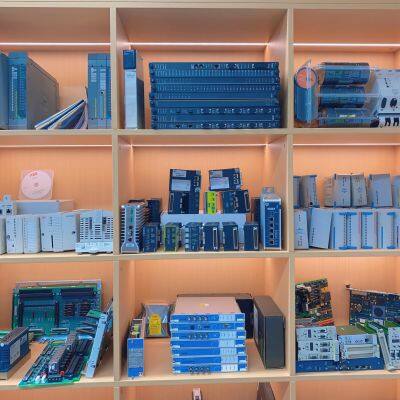Product Description
Vibro-Meter VM600 200-560-000-114 200-560-101-018 IOC4T is a key input/output control module that plays an indispensable role in the condition monitoring and control system of industrial equipment. With its excellent signal processing capability, stable operation performance and high system compatibility, it provides solid technical support for the safe and efficient operation of various key equipment in industrial production, and is an important guarantee for enterprises to realize intelligent equipment management and lean production.

I. Core Functions
(1) Efficient Signal Acquisition and Processing
Multi-channel signal access: The module is equipped with 4 dynamic signal input channels and 2 speed signal input channels. Each channel can be independently configured with parameters and can simultaneously connect various devices such as vibration sensors and speed sensors. In the monitoring scenario of large motor units, vibration sensors of the front and rear bearings of the motor and the speed sensor at the motor shaft end can be connected through different channels to synchronously collect vibration data and speed information during the motor operation, providing a complete data source for a comprehensive analysis of the motor operation status.
Precise signal conditioning: The module integrates a high-precision signal conditioning circuit, which can amplify, filter and isolate the input weak signals, effectively suppressing noise signals such as electromagnetic interference and common-mode interference in industrial sites. In the monitoring of rolling mills in steel plants, even if there are a large number of strong electromagnetic devices around, the IOC4T module can ensure that the signals obtained from the vibration sensors are clear and stable, truly reflecting the vibration state of the rolling mill, and providing a reliable basis for subsequent fault diagnosis.
Flexible signal conversion and output: It has a variety of signal output modes. Through the on-board digital-to-analog converter and voltage-current converter, the processed signal can be converted into 0-10V voltage signal or 4-20mA current signal output (flexibly selectable through jumpers), which is compatible with different types of control systems and display devices. In chemical production plants, the vibration signal of the compressor can be converted into a standard current signal and transmitted to the DCS system, so that operators can grasp the operation status of the compressor in real time in the central control room.
(2) Intelligent Equipment Monitoring and Alarm
Real-time status monitoring: The module can conduct real-time analysis of the collected signals, monitor key parameters such as vibration amplitude and speed of the equipment in real time, and compare them with preset normal thresholds to timely judge whether the equipment is in normal operation. In the monitoring of steam turbines, if the vibration amplitude suddenly increases and approaches the early warning threshold, the module can immediately capture this change, gaining time for timely maintenance of the equipment.
Multi-level alarm mechanism: It has 4 built-in local relays and supports multi-level alarm settings. Different alarm levels such as early warning, alarm and emergency shutdown can be set according to the severity of equipment faults. When the equipment parameters exceed the corresponding thresholds, the corresponding relays will act to trigger operations such as sound and light alarm and equipment shutdown. In the monitoring of generator sets, if the speed exceeds the dangerous threshold, the module can quickly trigger an emergency shutdown alarm, cut off the unit power supply, and avoid damage to the generator set due to overspeed.
Expansion and transmission of alarm information: It can transmit 32 digital signals representing alarm status to the rack backplane. These signals can be further expanded and processed by optional RLC 16 relay cards and IRC 4 intelligent relay cards on the rack, realizing multi-channel transmission of alarm information and complex control logic. In automated production lines, equipment alarm information can be sent to both the production line control center and on-site operation terminals in this way, facilitating rapid response and handling of faults.
(3) System Collaboration and Integration
Efficient communication in master-slave mode: Working in slave mode, it performs high-speed data interaction with the MPC4 module through the Industry Pack (IP) interface. The two work together: the IOC4T is responsible for signal acquisition, conditioning and output, while the MPC4 focuses on in-depth data analysis and processing, forming an efficient monitoring and analysis system. In the monitoring system of wind turbines, this collaborative mode can ensure the rapid transmission and analysis of data such as vibration and speed of the wind turbine, and timely detect potential faults.
Convenient integration with standardized interfaces: The front panel is equipped with standardized terminal connectors for connecting sensor transmission cables and external control systems, enabling the module to be easily integrated into various industrial automation systems. Whether it is a new equipment monitoring project or the upgrading and transformation of an existing system, the installation and integration of the module can be completed quickly, reducing the system construction cost and cycle. For example, in the robot monitoring system of an automobile manufacturing workshop, the IOC4T module can be seamlessly connected with the workshop's PLC system through standardized interfaces to realize real-time monitoring of the robot's operation status.

II. Hardware Characteristics
(1) Industrial-grade Durable Construction
Stable operation in a wide temperature range: Using industrial-grade components and optimized heat dissipation design, it can work stably in a wide temperature range of -20℃ to +70℃. In extreme environments such as cold northern oil fields or high-temperature southern metallurgical workshops, the module can maintain normal signal acquisition and processing performance, ensuring that equipment monitoring work is not affected by ambient temperature.
Strong anti-interference and protection: It has excellent electromagnetic compatibility, and effectively resists electromagnetic interference, radio frequency interference, etc. in industrial sites through multiple shielding and filtering designs. At the same time, it has an IP65 protection rating, with good dustproof and moisture-proof performance, and can operate stably for a long time in dusty and humid industrial environments (such as cement plants and paper mills), reducing the impact of environmental factors on the equipment.
Shock and vibration resistance: The structural design has passed strict mechanical tests, with certain shock and vibration resistance capabilities, and can adapt to the vibration and impact environment generated by the operation of industrial on-site equipment. In places with large vibrations such as heavy machinery workshops, the module can maintain a stable working state, ensuring the continuity and accuracy of monitoring data.
(2) Compact Design and Convenient Installation
Modular compact structure: Adopting a modular design, the overall structure is compact, small in size (for example, 120mm in length × 80mm in width × 40mm in height) and light in weight, suitable for installation on equipment control cabinets or on-site equipment with limited space. In scenarios where equipment layout is compact, such as CNC machine tools, its small size will not affect the normal operation and maintenance of the equipment.
Flexible installation methods: It supports various installation methods such as rail mounting and panel mounting. The installation process is simple and fast, and technicians can choose the appropriate installation method according to the actual on-site situation. During equipment transformation or adding new monitoring points, the installation and fixing of the module can be completed quickly, improving work efficiency.
(3) Reliable Power Management
Wide voltage power supply adaptation: It supports 24V DC wide voltage power supply and has a certain ability to adapt to voltage fluctuations, which can work stably in industrial sites where the power supply voltage fluctuates slightly. In industrial facilities in remote areas, even if the power supply is not stable enough, the module can ensure normal operation, ensuring the continuity of equipment monitoring.
Comprehensive power protection: It has overvoltage, overcurrent and short-circuit protection functions. When the power supply is abnormal, it can quickly cut off the power input to protect the internal circuit of the module from damage. In cases such as wrong power wiring or sudden failure of external power supply, it can effectively avoid module burnout and prolong the service life of the equipment.

III. Application Fields
(1) Energy and Power Industry
Power generation equipment monitoring: In thermal power plants, it can be used to monitor parameters such as vibration and speed of equipment such as steam turbines and generators. By collecting the vibration signals of steam turbine bearings and the speed signals of generators in real time, faults such as rotor imbalance and bearing wear can be found in time, ensuring the safe and stable operation of power generation equipment, improving power generation efficiency, and reducing shutdown losses caused by equipment faults.
Transmission and distribution equipment monitoring: It monitors transmission and distribution equipment such as transformers and high-voltage switches. By connecting vibration sensors and temperature sensors, it monitors the vibration state and operating temperature of the equipment, judges whether there are problems such as loose iron cores and poor contact of contacts inside the equipment, warns of equipment faults in advance, and ensures the reliability of power transmission.
(2) Petrochemical Industry
Key unit monitoring: In the process of petroleum refining and chemical production, it is used to monitor vibration and speed parameters of key units such as compressors, pumps and centrifuges. It grasps the operation status of the units in real time. When abnormal vibration or speed fluctuation occurs, it sends out alarm signals in time to remind operators to take measures to prevent production accidents caused by unit faults and ensure the continuity and safety of production.
Pipeline system monitoring: It monitors the vibration state of chemical pipelines. Through vibration sensors installed on the pipelines, it collects pipeline vibration signals, analyzes whether the pipelines have problems such as resonance and fluid impact, and timely finds hidden dangers such as pipeline leakage and loose supports to ensure the safe operation of the pipeline system.
(3) Manufacturing Industry
Machine tool equipment monitoring: In the mechanical processing industry, it is used to monitor parameters such as spindle vibration and feed shaft speed of machine tools such as CNC machine tools and machining centers. Through real-time monitoring, problems such as tool wear and spindle imbalance can be found in time, ensuring processing accuracy and product quality, and improving the service life and production efficiency of machine tool equipment.
Automated production line monitoring: In automated production lines such as automobile manufacturing and electronic production, it monitors the vibration and operating speed of equipment such as conveying equipment and assembly robots. When the equipment has abnormal vibration or speed deviation, the module sends out alarm signals, facilitating maintenance personnel to check and eliminate faults in time, ensuring the continuous and stable operation of the production line, and reducing losses caused by production interruption.
GE WES5123-1200 Remote Terminal Unit
Vibro-meter 200-582-500-021 VM600 RPS6U SIM-330A Power Supply
Vibro-meter SIM-275A 200-582-500-013 Power Supply
VIBRO-METER VM600 RPS6U 200-582-500-013 Rack Power Supply
Vibro-meter VM600 RPS6U 200-582-200-011 Power Supply
Vibro-meter 200-595-031-111 VM600 CPUM Input/Output Communications Network Card


VIBRO-METER 200-595-100-014 200-595-072-122 VM600 CPUM CPU Board
VIBRO-METER 600-003 620-001-001-116 VM600 XMV16 Regulator Module
VIBRO-METER 620-002-000-113 620-003-111-112 VM600 XIO16T Communication Interface Card
Vibro-meter MPC4 200-510-078-115 Machinery Protection Card
Vibro-meter VM600 MPC4 200-510-064-034 200-610-100-034 Machinery Protection Card
GE IS420YDIAS1B Discrete Output I/O Pack
GE IS420YAICS1B Analog I/O Pack
GE IS420YDOAS1B Discrete Output I/O Pack
GE IS410STCIS2A Compact Contact Input Terminal Board
GE IS410STAIS2A Analog I/O Module
GE IS410SRLYS2A Simplex Terminal Board
GE IS400STCIS2AFF Terminal Board
 yezi
Hi there! Welcome to my shop. Let me know if you have any questions.
yezi
Hi there! Welcome to my shop. Let me know if you have any questions.





